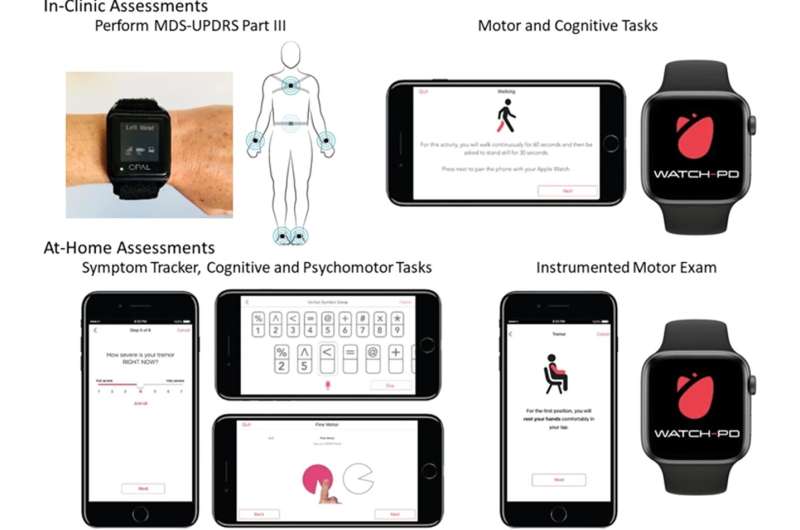This article has been reviewed according to Science X's editorial process and policies. Editors have highlighted the following attributes while ensuring the content's credibility:
fact-checked
trusted source
proofread
Smartwatches may be key to development of new Parkinson's treatments

New research shows that commercially available smartphones and watches, like the Apple Watch, are able to capture key features of early, untreated Parkinson's disease. These technologies could provide researchers with more objective and continuous ways to measure the disease and bring new treatments to market faster, particularly for patients in the early stages of the disease.
"This research shows that readily accessible and ubiquitous technology has the potential to detect and objectively measure severity and potentially progression of important symptoms of Parkinson's disease," said University of Rochester Medical Center (URMC) neurologists Jamie Adams, MD, first author of the study, which appears in the journal npj Parkinson's Disease.
While Parkinson's is the world's fastest growing brain disease, most of the drugs used to treat it were developed in the last century. The complexity of the disease and limitation of current measures have been barriers to new therapies.
Onset and severity of symptoms—such as stiffness in the arms and legs, movement and walking difficulty, and tremors—and progression of the disease can vary significantly from patient to patient. Furthermore, the tools traditionally used to track the disease are subjective and episodic, e.g. only collected during visits to the clinic, limiting insight into how Parkinson's disease affects people's daily lives.
Researchers with the URMC Center for Health + Technology (CHeT) have been pioneers in harnessing digital health technologies such as telemedicine, wearables, remote monitoring, and mobile apps to improve access to care and conduct decentralized clinical trials. In 2015, URMC neurologist Ray Dorsey, MD, and the CHeT team collaborated with Sage Bionetworks to launch the first smartphone research application to monitor Parkinson's disease in real time.
Apple featured the app, called mPower, during their semi-annual product launch event, and 15,000 individuals participated in research using the application. Studies have shown that mPower and another Android app can accurately track the severity of the symptoms of Parkinson's disease. Dorsey is the senior author of the new smartwatch study.
Since the launched of mPower, the proliferation of smartwatches and technological improvements, particularly in gyroscopes and accelerometers that can more precisely measure movement, has heightened the research potential of these devices.
In the new WATCH-PD study, researchers at multiple sites across the U.S. recruited 82 individuals with early, untreated Parkinson's and 50 age-matched controls and followed them for 12 months. The study volunteers wore research-grade sensors, an Apple Watch, and an iPhone while performing standardized assessments in clinic. At home, participants wore the smartwatch for seven days after each clinic visit and completed motor, speech, and cognitive tasks on the smartphone every other week.
The smartphone app tracked finger-taping speed, performance on cognitive tasks, and speech, while the smartwatch was able to measure arm movement, duration of tremors, and gait features.
The researchers were able to detect motor and non-motor features that differed between individuals with early Parkinson's and age-matched controls. The team performing longitudinal analysis and also conducting a study that will follow participants for a longer period to determine which digital measures are sensitive enough to help researchers evaluate whether an experimental therapy is making a meaningful impact on the progression of the disease.
"These findings reinforce what other studies have shown—digital devices can differentiate between people with and without early Parkinson's and are more sensitive than traditional rating scales for some measures of Parkinson's disease," said Adams. For example, the researchers note that the smartphone app detected abnormalities in speech rated "normal" by investigators. "Better measures will lead to more efficient, patient-centric, and timely evaluation of therapies."
More information: Jamie L. Adams et al, Using a smartwatch and smartphone to assess early Parkinson's disease in the WATCH-PD study, npj Parkinson's Disease (2023). DOI: 10.1038/s41531-023-00497-x




















